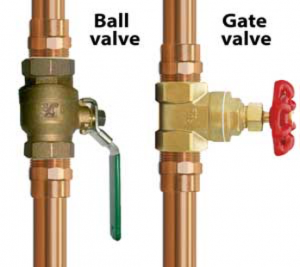Leak Detection Tip – Where’s Your Main Water Shutoff Valve?

It seems like a simple piece of knowledge for a facility manager: knowing where your main water shutoff valve is located. Unfortunately, knowing exactly where the valve is situated in a building comes to some operators too late. Because we’ve worked in numerous types of facilities across the country, we’ve encountered far too many people who didn’t know where their water main shutoff valve was until after substantial water damaged had occurred.
The Leak Detection Tip
- Know where your main water shutoff valve is located!
The Reason
During colder months, pipes have a tendency to repeatedly freeze and thaw. Additionally, an increase in precipitation in many parts of the country leads to flooding and other weather-related fluid intrusion. Because any water-related issue can cause serious damage to a facility, in particular buildings housing sensitive equipment, operators have to know how to shut off a main source of water in the event of a burst pipe or other failure. Some water cannot be controlled (like torrential rains and flooding from Mother Nature), but if it can, it should be.
Within the first few weeks of this year, we identified several stories of water damage due to burst pipes:
- Spencerport High School in Spencerport, NY evacuated students.
- River Park Square shops in Spokane, WA alerted the Fire Department.
- Witchita Museum in Witchita, KS closed exhibits.
- SpringHill Suites by Marriott in Southern Pines, NC removed guests from the building.
Education, hospitality, and commercial industries were all among those affected by a burst pipe over the last couple of weeks. These companies or institutions experienced a loss of revenue and productivity (and perhaps future liability) due to burst pipes and the resulting water damage. Hopefully, all employed a monitoring system to alert their facility managers that a crisis was occurring so that response could be quick to minimize the damage. Given the extent of harm to the structures outlined in the articles and the impact on their constituents, there is probably room for improvement.
Locate Your Valve
Shutting the main water supply valve is is a task you’ll want to know how to do before you actually need to do it. Take a look at your facility today, learn where your main shutoff is located, and ensure it’s in good working order.
- Locate the Valve – The main water supply valve is usually located on an outside wall in a basement or utility are of your facility.
- Know How to Operate Your Valve – The valve will usually be either a gate valve or a ball valve. Your valve may not have been turned in a long time – or ever! Take the time now to ensure your valve is in good repair and working properly.

- Gate Valve – A gate valve has a dial. Turn the handle CLOCKWISE (to the RIGHT) to close it. When you turn the handle, do not apply excessive force or jerk the handle. This can bend and damage the gate, or snap the valve stem. This can cause the valve to break in either the closed or open position. Balkan Plumbing has some excellent gate valve information and illustrations, and a fantastic video.
- Ball Valve – A ball valve has a lever. If the lever is in line with the pipe, the valve is OPEN. If the lever is perpendicular to the pipe, the lever is CLOSED.
Be Prepared
We’ve previously examined the effect of leaks in a mission critical facility for Facility Executive. As part of our best practices highlighting vulnerabilities, we listed both “Piping Issues” and “Environmental Intrusion” as elements to watch in order to maximize the use of leak detection technology to monitor a facility. A burst pipe can impact both of these areas of concern. This is especially important in critical facilities, but nevertheless imperative in other kinds of buildings as well to help avoid incidents like the examples above. The first step is to install leak detection and environmental monitoring solutions, but in the event of a burst pipe, just the basic knowledge of knowing where that main water shutoff valve is located goes far minimize the damage that can occur.
We certainly hope you won’t experience a burst pipe this winter and can continue to proactively monitor your critical spaces for leaks and fluid intrusions. If a pipe ruptures however, please be prepared! While we can tell you where the leak is, you have to know how to shut off the water to the area affected to remain proactive, perform repairs, and resume optimal operating conditions.
Leave a Reply
